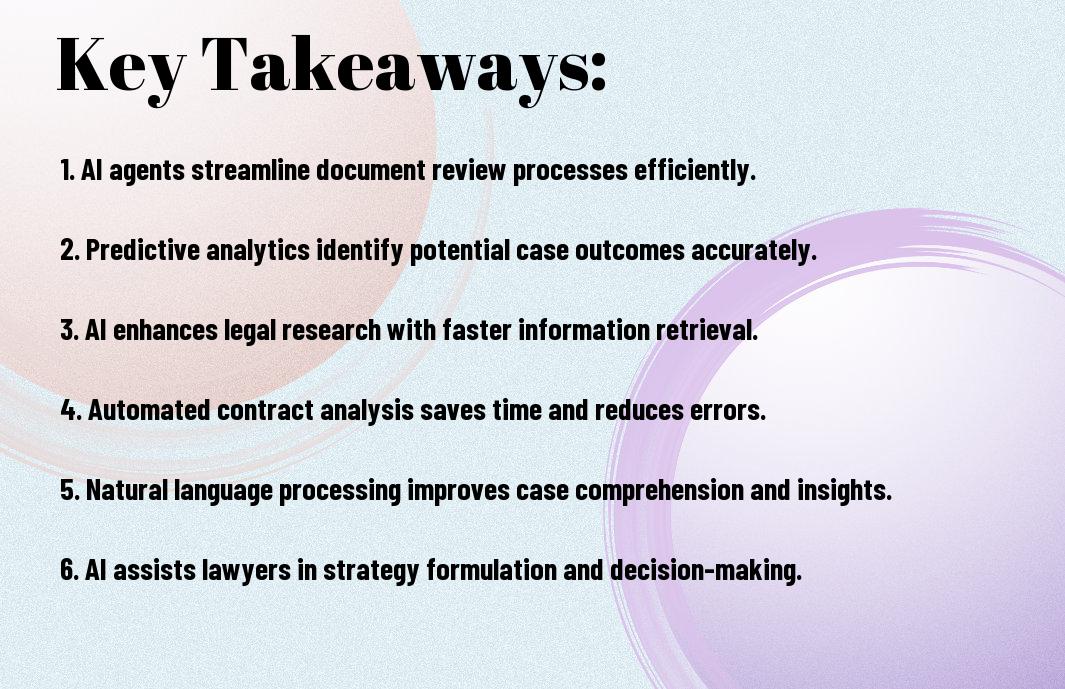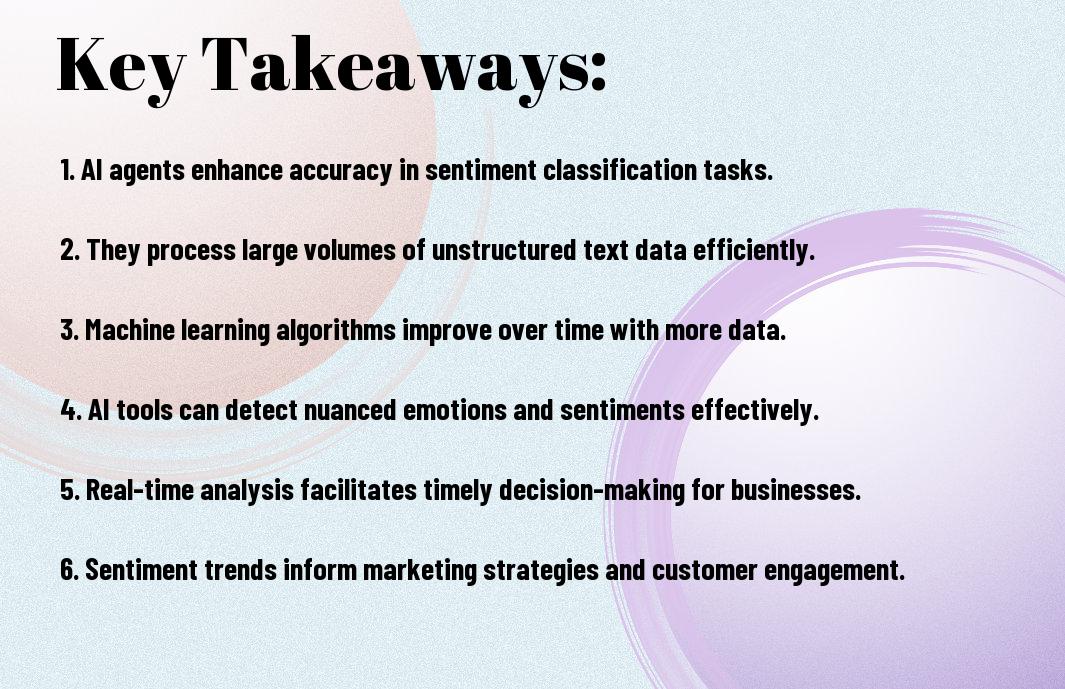As you navigate the complex world of legal case analysis, you may wonder how artificial intelligence (AI) is impacting this field. You will discover that AI agents are being increasingly utilized to streamline and enhance your analysis. Your ability to analyze large amounts of data quickly and accurately is improved with AI agents, allowing you to make more informed decisions in your legal cases. You will learn how AI agents can assist you in identifying patterns and predicting outcomes.
Key Takeaways:
- Efficient Document Review is a key application of AI Agents in legal case analysis, enabling faster and more accurate examination of large volumes of documents to identify relevant information and evidence.
- Predictive Analytics is another significant use of AI Agents, helping lawyers to forecast the likelihood of success in a case, identify potential risks, and develop more effective Case Strategies.
- Automated Research assisted by AI Agents facilitates the legal research process, quickly searching through vast amounts of Legal Precedents and Regulations to provide relevant information and support the development of strong legal arguments.

Legal Framework
Your understanding of the legal framework is vital to appreciate the role of AI agents in legal case analysis. It provides the foundation for the application of AI technology in the legal profession.
Overview of Legal Systems
Foundational to the discussion is the structure of legal systems, which varies by jurisdiction, influencing how AI agents are utilized in legal case analysis, helping you navigate the complexities of different legal frameworks.
Role of Technology in Law
Beneath the surface of traditional legal practices, technology is transforming the way legal cases are handled, enabling you to streamline processes and improve efficiency with the aid of AI agents.
Further, the integration of technology in law is leading to the development of more sophisticated AI agents, capable of analyzing vast amounts of data, identifying patterns, and providing insights that can significantly impact the outcome of legal cases, allowing you to make more informed decisions.

AI Agents in Legal Analysis
Clearly, AI agents are transforming the field of legal case analysis by providing you with efficient and accurate tools to analyze large amounts of data. You can now rely on AI to help you identify patterns, predict outcomes, and make informed decisions.
Natural Language Processing
Among the key technologies used in AI agents, natural language processing enables you to analyze and understand large volumes of textual data, such as legal documents and case files, allowing you to extract relevant information and insights.
Machine Learning Algorithms
After deploying AI agents, you can leverage machine learning algorithms to analyze complex legal data, identifying relationships and patterns that may inform your legal strategy, and enabling you to make more effective decisions.
For instance, machine learning algorithms can help you analyze past court decisions, identifying trends and patterns that can inform your legal arguments, and providing you with valuable insights to strengthen your case, allowing you to develop a more effective legal strategy tailored to your specific needs and goals.
Applications of AI Agents
To effectively analyze legal cases, you can leverage AI agents in various ways, streamlining your workflow and improving outcomes.
Document Review and Management
By utilizing AI agents, you can efficiently manage and review large volumes of documents, extracting relevant information and identifying key evidence to support your case.
Predictive Analytics and Insights
Between the complexities of legal data and the need for informed decision-making, you can use AI agents to uncover patterns and predict outcomes, helping you make strategic choices.
At the heart of predictive analytics and insights is the ability to analyze large datasets, identify trends, and forecast potential case outcomes, allowing you to refine your strategy and make data-driven decisions that support your legal arguments, ultimately enhancing your chances of success in court, and you can use this capability to your advantage.
Benefits and Challenges
Despite the potential of AI agents in legal case analysis, you will encounter various benefits and challenges when implementing these tools in your practice.
Improved Efficiency and Accuracy
By leveraging AI agents, you can streamline your workflow and reduce the time spent on tedious tasks, allowing you to focus on higher-level analysis and strategy.
Ethical Concerns and Limitations
Ethically, you must consider the potential biases in AI decision-making and ensure that your use of these tools aligns with your professional obligations and values.
Also, as you explore the use of AI agents in legal case analysis, you will need to address concerns around data privacy, security, and the potential for AI to replace human judgment in certain aspects of legal decision-making, which can have significant implications for your clients and the broader justice system.
Current Trends and Developments
After exploring the basics of AI agents in legal case analysis, you can now explore into the current trends shaping this field. You will find that advancements in technology and emerging applications are significantly impacting your understanding and utilization of AI agents.
Advancements in AI Technology
One notable aspect of current trends is the rapid improvement in AI algorithms, allowing you to process complex data more efficiently and effectively, thereby enhancing your legal case analysis capabilities.
Emerging Applications in Law
The integration of AI agents in law is leading to innovative solutions, enabling you to automate tasks, predict outcomes, and make more informed decisions, which in turn, enhances your overall legal practice.
Consequently, as you explore emerging applications in law, you will discover that AI agents are being used in contract review, litigation prediction, and even in providing personalized legal advice, making your work more streamlined and efficient, and allowing you to focus on high-value tasks that require your expertise and judgment.
Future Prospects
Now, as you explore the potential of AI agents in legal case analysis, you can learn more about AI agents for legal: Applications, benefits, implementation and more. This will help you understand the technology’s capabilities and limitations.
Potential Impact on Legal Profession
Legally, you will need to consider how AI agents might change the way you work, making some tasks more efficient and others obsolete, altering your role in the legal system.
Need for Regulatory Frameworks
Prospective developments in AI agent technology will require you to think about the need for guidelines and standards to ensure their use is fair and transparent, affecting your decisions and actions in the legal field.
But as you probe deeper into the possibilities of AI agents in law, you will find that creating these frameworks is vital to prevent potential misuse and ensure that you can trust the technology, and that it aligns with your values and the principles of justice, making your work more effective and reliable.
To wrap up
So, as you explore the use of AI agents in legal case analysis, you’ll find that they significantly enhance your ability to review and manage large volumes of data. You can learn more about The Role of AI Agents in Revolutionizing Legal Document Management to improve your understanding of how these agents can streamline your workflow and increase productivity.
FAQ
Q: What role do AI agents play in legal case analysis, and how do they assist lawyers and judges in making informed decisions?
A: AI agents are used in legal case analysis to help lawyers and judges analyze large volumes of data, identify relevant information, and predict potential outcomes. They can review and analyze documents, such as contracts, court transcripts, and evidence, to identify patterns and connections that may not be immediately apparent to human reviewers. AI agents can also help with tasks such as document classification, entity extraction, and sentiment analysis, freeing up time for lawyers and judges to focus on higher-level tasks like strategy and decision-making.
Q: How do AI agents help with predictive analytics in legal case analysis, and what benefits do they offer in terms of forecasting case outcomes?
A: AI agents can be trained on large datasets of past court cases to develop predictive models that forecast the likelihood of a particular outcome in a given case. By analyzing factors such as the strength of the evidence, the credibility of witnesses, and the legal precedents involved, AI agents can provide lawyers and judges with data-driven insights to inform their decisions. This can help parties to a case make more informed settlement decisions, and can also help judges to manage their dockets more efficiently. Additionally, AI agents can help identify potential risks and opportunities in a case, allowing lawyers to develop more effective strategies and tactics.
Q: Are AI agents capable of replacing human lawyers and judges in legal case analysis, or do they augment their capabilities and enhance the overall efficiency of the legal process?
A: AI agents are not intended to replace human lawyers and judges, but rather to augment their capabilities and enhance the overall efficiency of the legal process. While AI agents can analyze data and identify patterns with a high degree of accuracy, they lack the nuance and judgment that human lawyers and judges bring to the table. AI agents are best used as a tool to support and assist lawyers and judges, providing them with data-driven insights and recommendations that can inform their decisions. By automating routine tasks and providing predictive analytics, AI agents can help to streamline the legal process, reduce costs, and improve outcomes for all parties involved.




